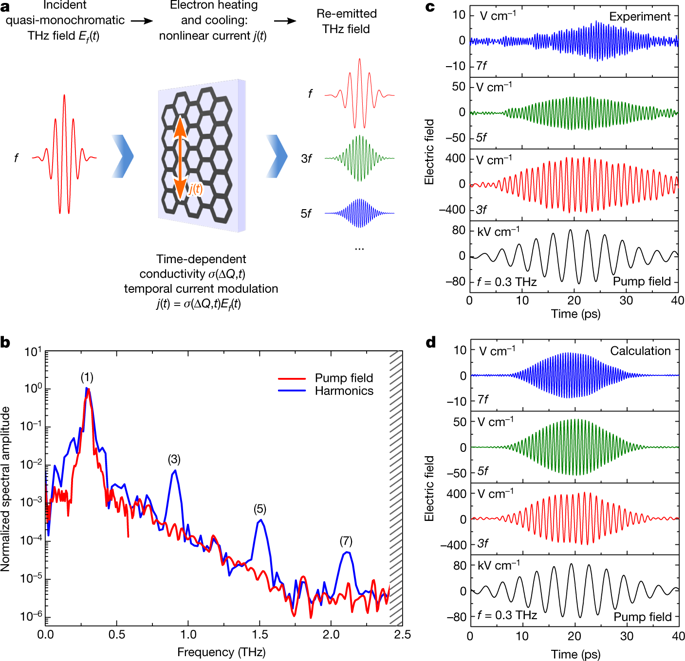Our official English website, www.x-mol.net, welcomes your
feedback! (Note: you will need to create a separate account there.)
Extremely efficient terahertz high-harmonic generation in graphene by hot Dirac fermions
Nature ( IF 50.5 ) Pub Date : 2018-09-01 , DOI: 10.1038/s41586-018-0508-1 Hassan A. Hafez , Sergey Kovalev , Jan-Christoph Deinert , Zoltán Mics , Bertram Green , Nilesh Awari , Min Chen , Semyon Germanskiy , Ulf Lehnert , Jochen Teichert , Zhe Wang , Klaas-Jan Tielrooij , Zhaoyang Liu , Zongping Chen , Akimitsu Narita , Klaus Müllen , Mischa Bonn , Michael Gensch , Dmitry Turchinovich
Nature ( IF 50.5 ) Pub Date : 2018-09-01 , DOI: 10.1038/s41586-018-0508-1 Hassan A. Hafez , Sergey Kovalev , Jan-Christoph Deinert , Zoltán Mics , Bertram Green , Nilesh Awari , Min Chen , Semyon Germanskiy , Ulf Lehnert , Jochen Teichert , Zhe Wang , Klaas-Jan Tielrooij , Zhaoyang Liu , Zongping Chen , Akimitsu Narita , Klaus Müllen , Mischa Bonn , Michael Gensch , Dmitry Turchinovich

|
Multiple optical harmonic generation—the multiplication of photon energy as a result of nonlinear interaction between light and matter—is a key technology in modern electronics and optoelectronics, because it allows the conversion of optical or electronic signals into signals with much higher frequency, and the generation of frequency combs. Owing to the unique electronic band structure of graphene, which features massless Dirac fermions1–3, it has been repeatedly predicted that optical harmonic generation in graphene should be particularly efficient at the technologically important terahertz frequencies4–6. However, these predictions have yet to be confirmed experimentally under technologically relevant operation conditions. Here we report the generation of terahertz harmonics up to the seventh order in single-layer graphene at room temperature and under ambient conditions, driven by terahertz fields of only tens of kilovolts per centimetre, and with field conversion efficiencies in excess of 10−3, 10−4 and 10−5 for the third, fifth and seventh terahertz harmonics, respectively. These conversion efficiencies are remarkably high, given that the electromagnetic interaction occurs in a single atomic layer. The key to such extremely efficient generation of terahertz high harmonics in graphene is the collective thermal response of its background Dirac electrons to the driving terahertz fields. The terahertz harmonics, generated via hot Dirac fermion dynamics, were observed directly in the time domain as electromagnetic field oscillations at these newly synthesized higher frequencies. The effective nonlinear optical coefficients of graphene for the third, fifth and seventh harmonics exceed the respective nonlinear coefficients of typical solids by 7–18 orders of magnitude7–9. Our results provide a direct pathway to highly efficient terahertz frequency synthesis using the present generation of graphene electronics, which operate at much lower fundamental frequencies of only a few hundreds of gigahertz.Efficient terahertz harmonic generation—challenging but important for ultrahigh-speed optoelectronic technologies—is demonstrated in graphene through a nonlinear process that could potentially be generalized to other materials.
中文翻译:

热狄拉克费米子在石墨烯中产生极其高效的太赫兹高次谐波
多重光谐波的产生——光与物质之间非线性相互作用导致光子能量的倍增——是现代电子学和光电学的一项关键技术,因为它允许将光或电子信号转换为更高频率的信号,并且频率梳的产生。由于石墨烯具有独特的电子能带结构,它具有无质量的狄拉克费米子 1-3,人们一再预测,石墨烯中的光谐波产生在技术上重要的太赫兹频率 4-6 上应该特别有效。然而,这些预测尚未在技术相关的操作条件下通过实验得到证实。在这里,我们报告了在室温和环境条件下在单层石墨烯中产生高达七阶的太赫兹谐波,由每厘米只有几十千伏的太赫兹场驱动,场转换效率超过 10-3, 10-4 和 10-5 分别用于三次、五次和七次太赫兹谐波。考虑到电磁相互作用发生在单个原子层中,这些转换效率非常高。在石墨烯中如此高效地产生太赫兹高次谐波的关键是其背景狄拉克电子对驱动太赫兹场的集体热响应。通过热狄拉克费米子动力学产生的太赫兹谐波,在时域中直接观察到这些新合成的更高频率的电磁场振荡。石墨烯的三次、五次和七次谐波的有效非线性光学系数比典型固体的各自非线性系数高 7-18 个数量级 7-9。我们的研究结果提供了使用当代石墨烯电子器件实现高效太赫兹频率合成的直接途径,该电子器件在仅几百 GHz 的低得多的基频下运行。 高效的太赫兹谐波生成——具有挑战性但对超高速光电技术很重要——通过非线性过程在石墨烯中得到证明,该过程可能会推广到其他材料。石墨烯的三次、五次和七次谐波的有效非线性光学系数比典型固体的各自非线性系数高 7-18 个数量级 7-9。我们的结果提供了使用当代石墨烯电子器件实现高效太赫兹频率合成的直接途径,该电子器件在仅几百 GHz 的低得多的基频下运行。 高效的太赫兹谐波生成——具有挑战性但对超高速光电技术很重要——通过非线性过程在石墨烯中得到证明,该过程可能会推广到其他材料。石墨烯的三次、五次和七次谐波的有效非线性光学系数比典型固体的各自非线性系数高 7-18 个数量级 7-9。我们的研究结果提供了使用当代石墨烯电子器件实现高效太赫兹频率合成的直接途径,该电子器件在仅几百 GHz 的低得多的基频下运行。 高效的太赫兹谐波生成——具有挑战性但对超高速光电技术很重要——通过非线性过程在石墨烯中得到证明,该过程可能会推广到其他材料。
更新日期:2018-09-01
中文翻译:

热狄拉克费米子在石墨烯中产生极其高效的太赫兹高次谐波
多重光谐波的产生——光与物质之间非线性相互作用导致光子能量的倍增——是现代电子学和光电学的一项关键技术,因为它允许将光或电子信号转换为更高频率的信号,并且频率梳的产生。由于石墨烯具有独特的电子能带结构,它具有无质量的狄拉克费米子 1-3,人们一再预测,石墨烯中的光谐波产生在技术上重要的太赫兹频率 4-6 上应该特别有效。然而,这些预测尚未在技术相关的操作条件下通过实验得到证实。在这里,我们报告了在室温和环境条件下在单层石墨烯中产生高达七阶的太赫兹谐波,由每厘米只有几十千伏的太赫兹场驱动,场转换效率超过 10-3, 10-4 和 10-5 分别用于三次、五次和七次太赫兹谐波。考虑到电磁相互作用发生在单个原子层中,这些转换效率非常高。在石墨烯中如此高效地产生太赫兹高次谐波的关键是其背景狄拉克电子对驱动太赫兹场的集体热响应。通过热狄拉克费米子动力学产生的太赫兹谐波,在时域中直接观察到这些新合成的更高频率的电磁场振荡。石墨烯的三次、五次和七次谐波的有效非线性光学系数比典型固体的各自非线性系数高 7-18 个数量级 7-9。我们的研究结果提供了使用当代石墨烯电子器件实现高效太赫兹频率合成的直接途径,该电子器件在仅几百 GHz 的低得多的基频下运行。 高效的太赫兹谐波生成——具有挑战性但对超高速光电技术很重要——通过非线性过程在石墨烯中得到证明,该过程可能会推广到其他材料。石墨烯的三次、五次和七次谐波的有效非线性光学系数比典型固体的各自非线性系数高 7-18 个数量级 7-9。我们的结果提供了使用当代石墨烯电子器件实现高效太赫兹频率合成的直接途径,该电子器件在仅几百 GHz 的低得多的基频下运行。 高效的太赫兹谐波生成——具有挑战性但对超高速光电技术很重要——通过非线性过程在石墨烯中得到证明,该过程可能会推广到其他材料。石墨烯的三次、五次和七次谐波的有效非线性光学系数比典型固体的各自非线性系数高 7-18 个数量级 7-9。我们的研究结果提供了使用当代石墨烯电子器件实现高效太赫兹频率合成的直接途径,该电子器件在仅几百 GHz 的低得多的基频下运行。 高效的太赫兹谐波生成——具有挑战性但对超高速光电技术很重要——通过非线性过程在石墨烯中得到证明,该过程可能会推广到其他材料。











































 京公网安备 11010802027423号
京公网安备 11010802027423号